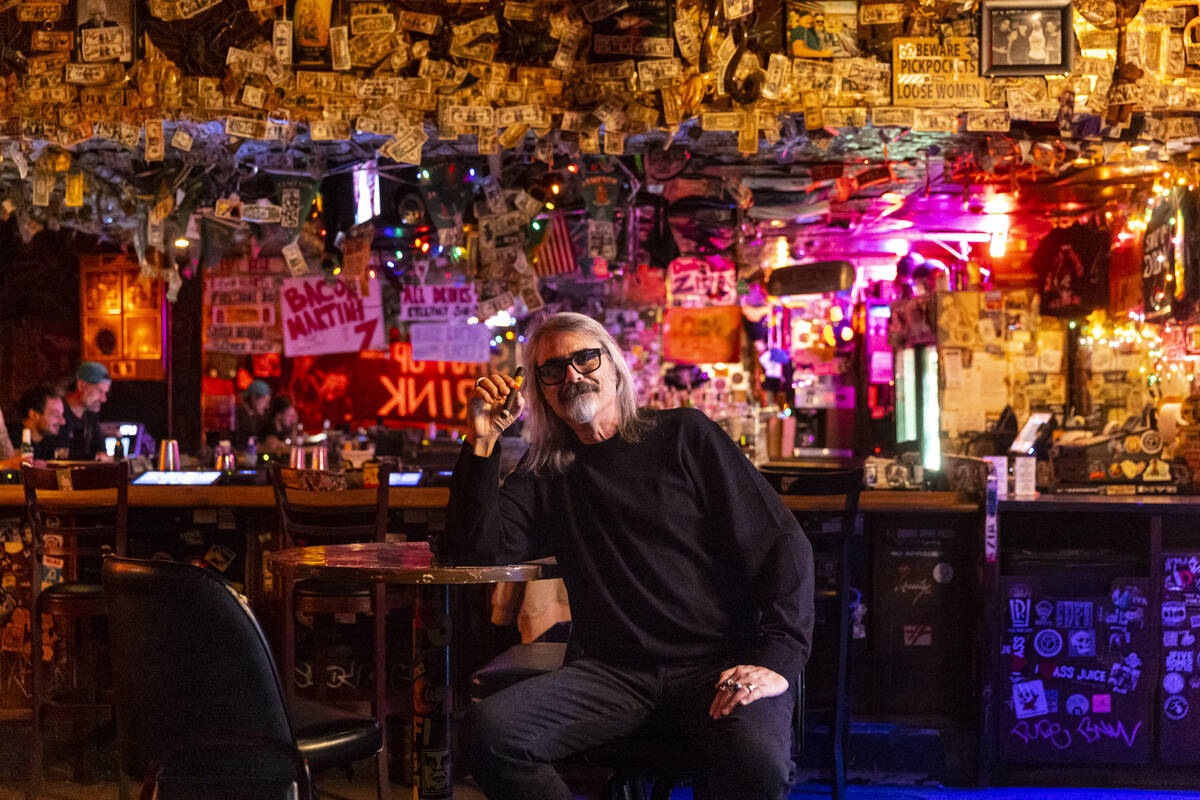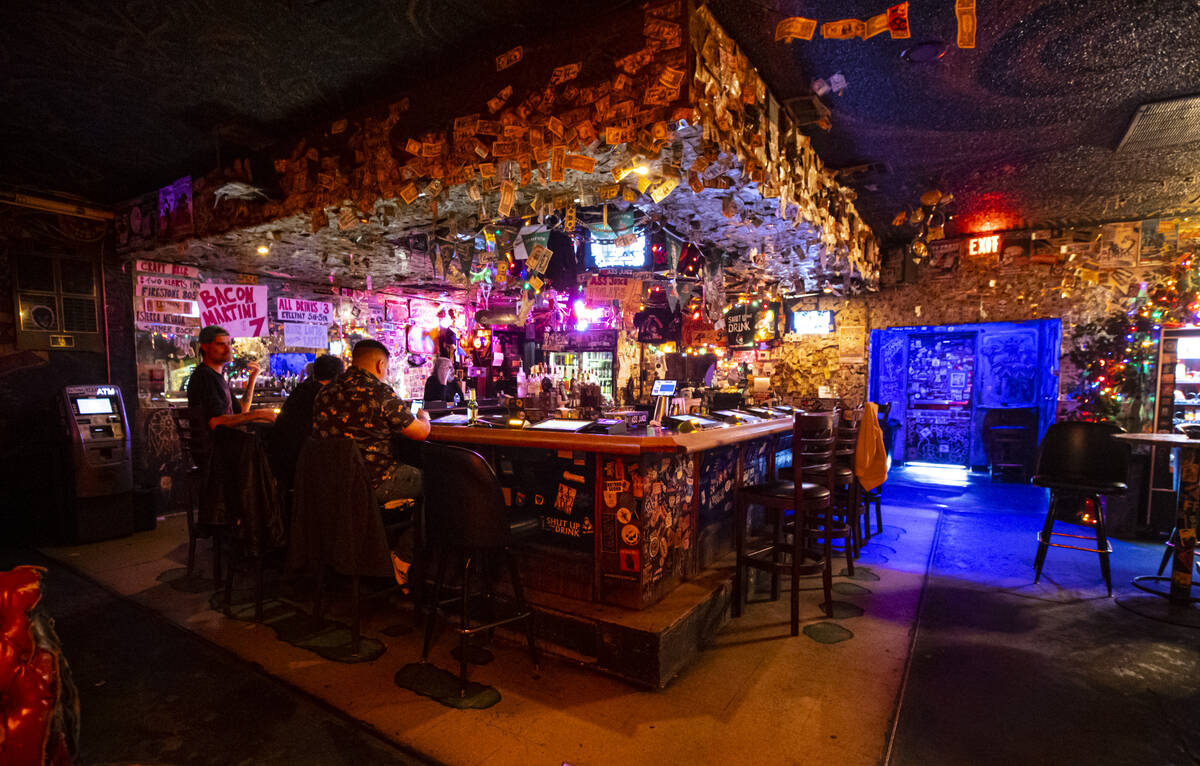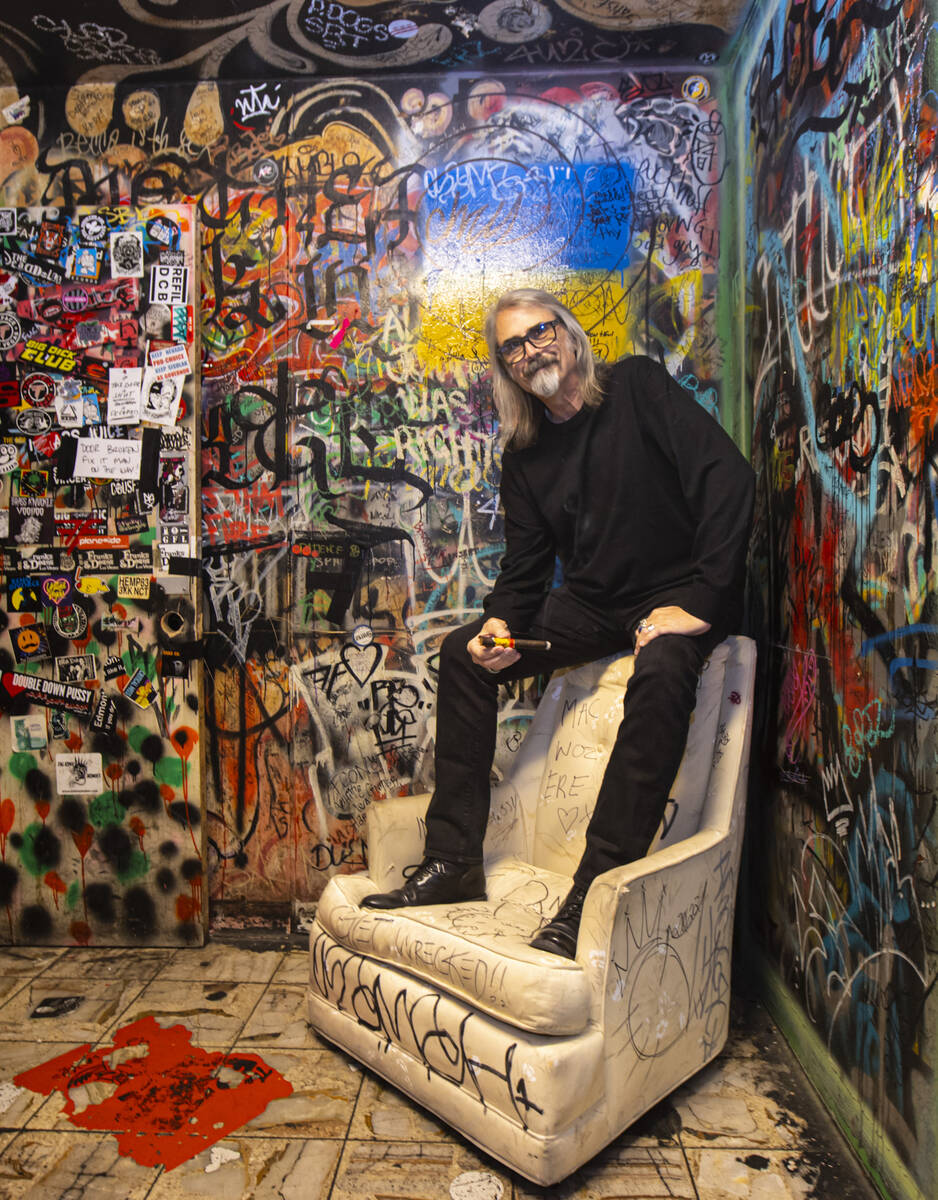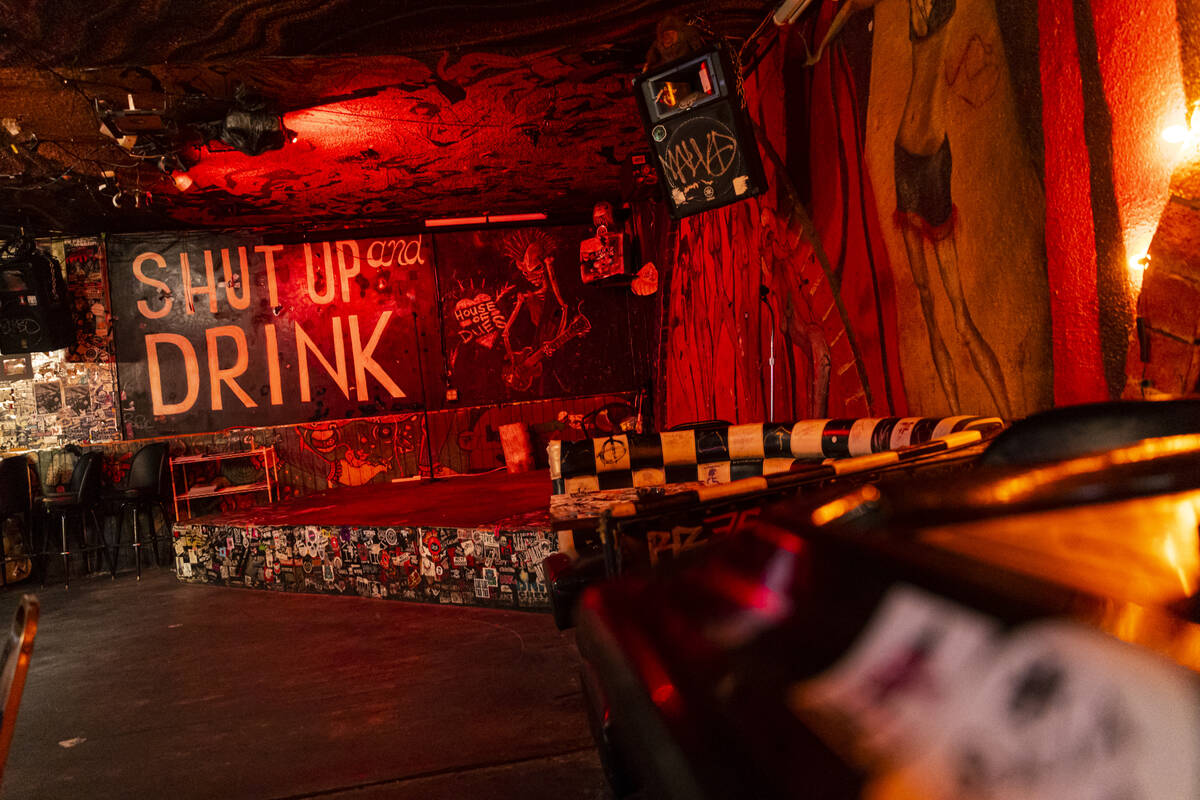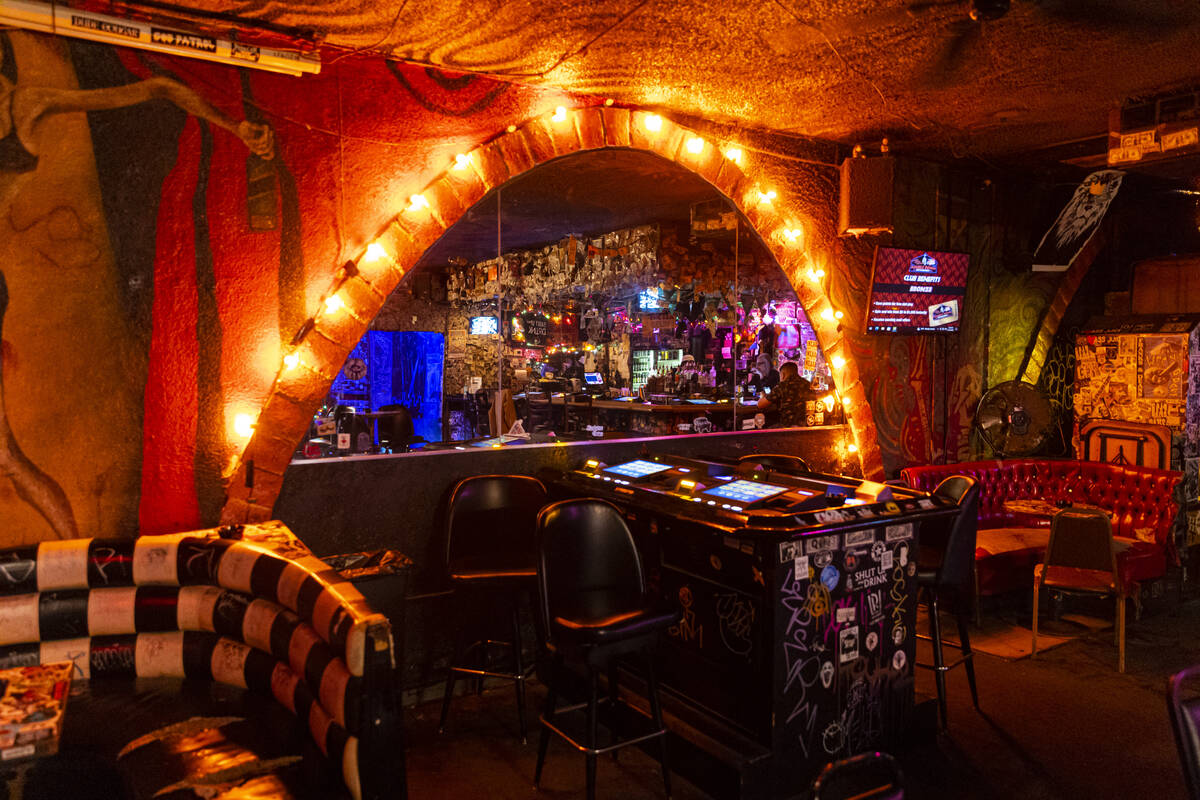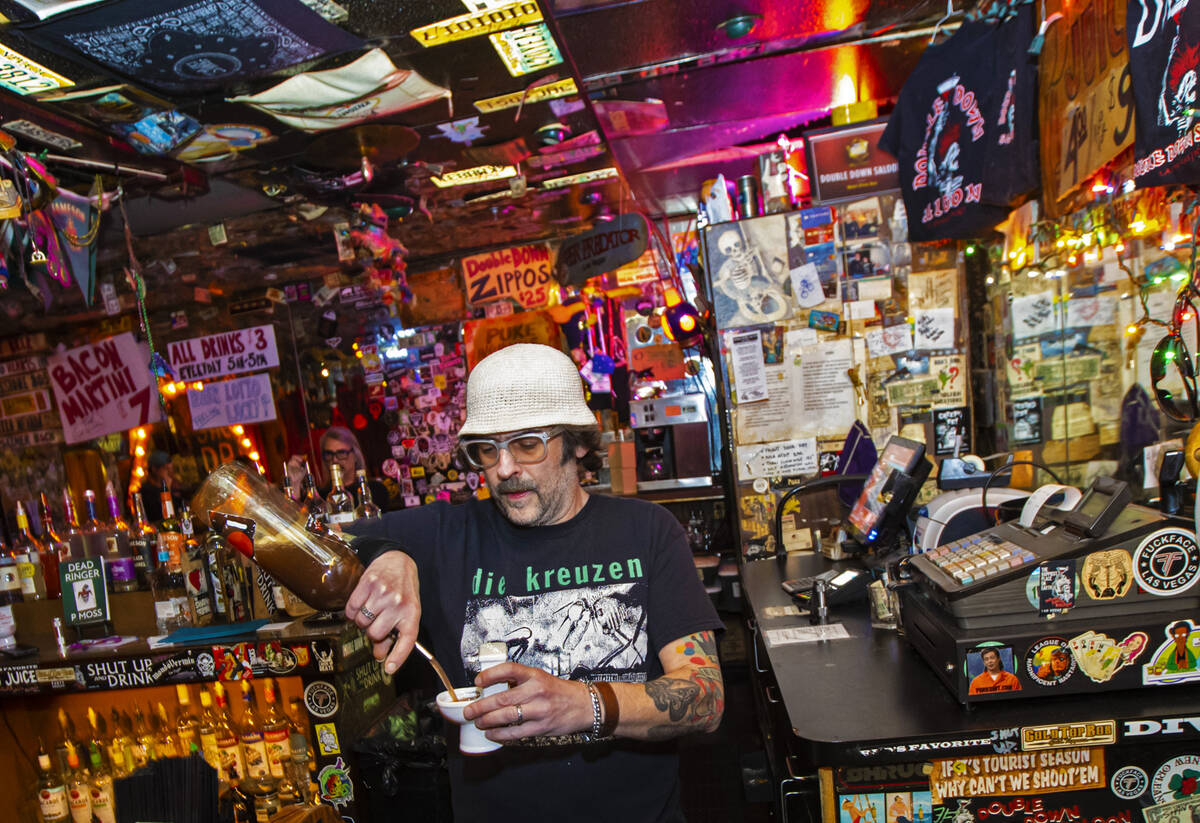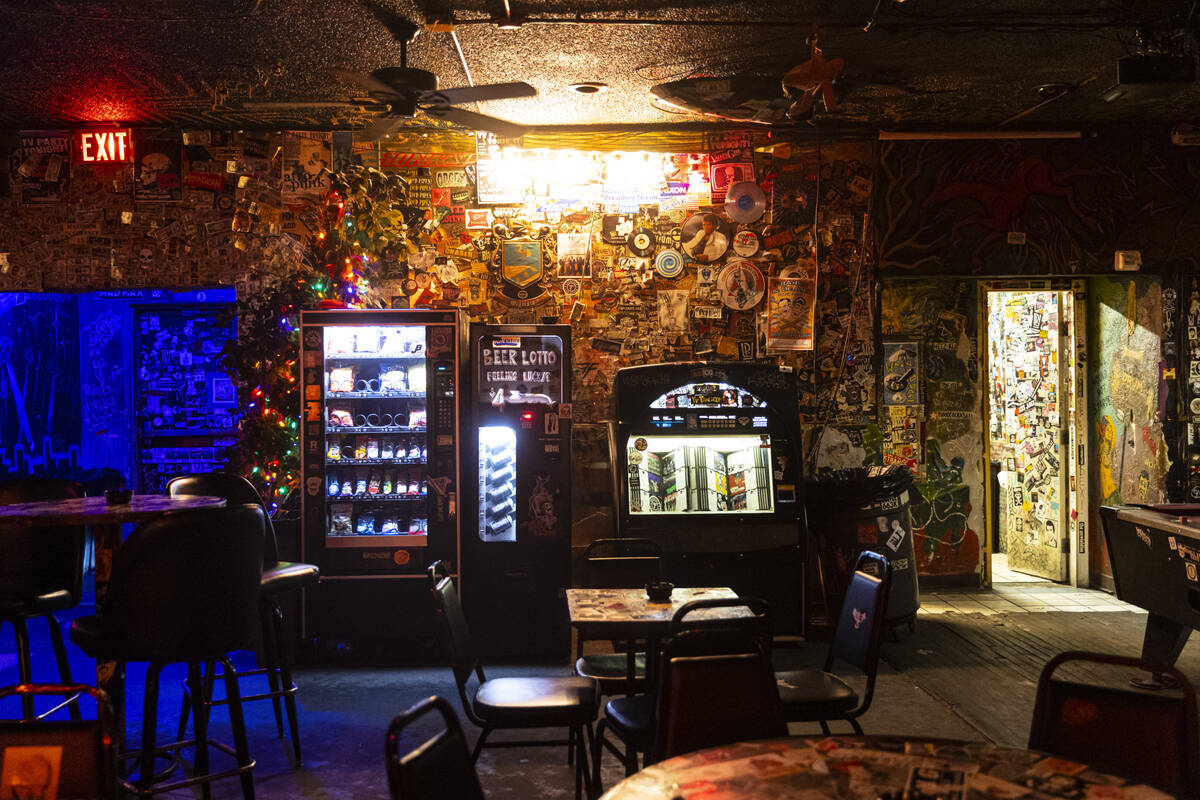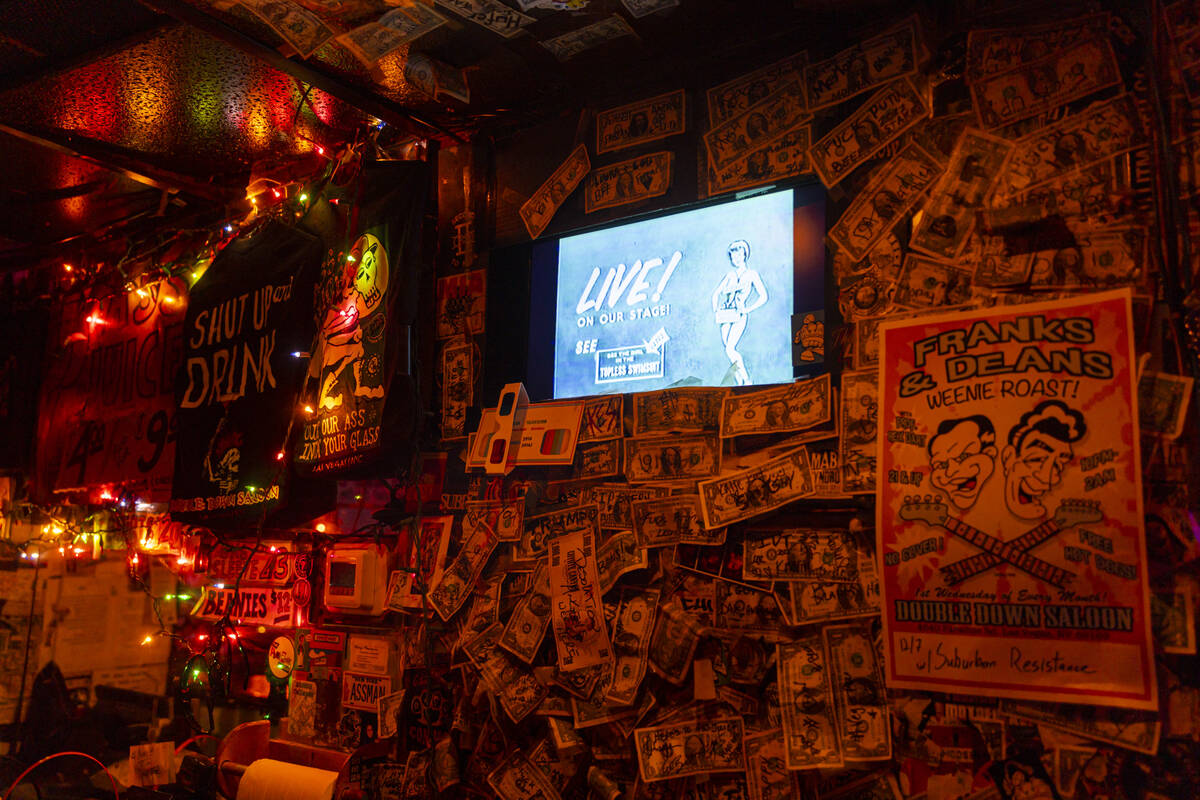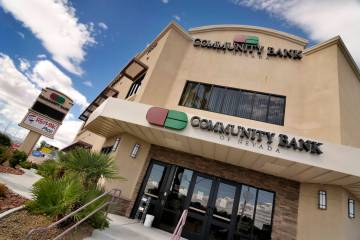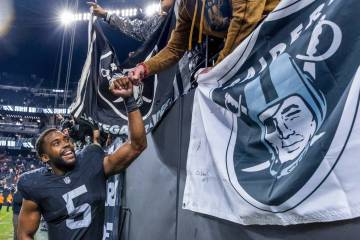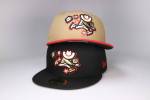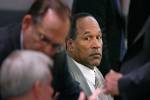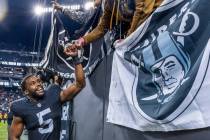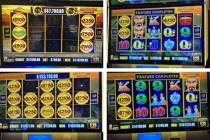Broken toilets, bizarre videos and cheap booze: Double Down Saloon turns 30
He says the word as if it came coated in something truly repulsive, like battery acid, rancid milk or normality.
“When I opened up, every bar in the town was the same,” P Moss notes with the visible distaste of someone who’s just swallowed a bug or perhaps a mouthful of grimace-inducing Czech liqueur Becherovka (more on that stuff later). “They were identical. They all had chicken wings and 15 (gaming) machines and ESPN on the TV.”
Then comes a dictionary-worthy example of a rhetorical question.
“That was never going to be this, you know?”
Hair silver, wardrobe black, words frequently blue, Moss cuts a distinct figure.
And so does the bar clamoring outside the back-room office in which its founder sits on a recent Friday afternoon, explaining how the self-anointed “Happiest Place on Earth” came to be.
The origins of the Double Down Saloon are as straightforward and to the point as the punk rock riot starters that fill its jukebox.
“I wanted to own a bar that I would want to be at as a customer,” Moss explains, seated beneath a sticker that reads “Punk Rock is Not a Crime. “A place where I would feel good, where I would want to hang out.”
Turns out a few million others have wanted the same.
In the three decades since opening in 1992, the Double Down has become one of the most iconic dives in the country, as Moss and business partner Chris Andrasfay, who oversees much of the day-to-day operations of the place, have turned the little-bar-that-could into a big hit.
Dark, loud and welcoming, the place somehow feels debauched and familial at once, the rare joint where movie stars and crust punks can feel equally at home, indulging in bacon martinis beneath walls adorned with homemade signs advertising puke insurance and drink specials involving Twinkies.
The late chef and TV personality Anthony Bourdain counted it among his top five favorite bars, comedian Dave Attel got loose there during an episode of his liver-punishing “Insomniac” show, and it’s been raved about in the pages of Rolling Stone, Playboy and Maxim, to name but a few.
The Double Down’s success has spread beyond its hometown, even: In 2006, Moss opened a sister location in New York City, which has since been written up glowingly in The New Yorker.
Moss accomplished all this at a once largely barren, rough-and-tumble stretch of Paradise Avenue and Naples Drive about as hospitable to growing a business as a slab of concrete is to growing a garden.
“In the beginning, no one knew what to make of this place,” Moss says. “Cabdrivers wouldn’t drop people off here.”
But what to make of it now?
As the Double Down celebrates its 30th anniversary, let’s take a look at what makes this a punk rock dive like no other:
Those bathrooms
How to describe the Double Down bathrooms? Aesthetically speaking, think of a heavily graffitied boxcar hit by a tornado of band stickers and then plunged into a deep ravine of broken toilets. There’s a gritty charm to them — who can’t appreciate a cardboard toilet tank top? — even though they weren’t initially intended to look this way. Moss has gotten a lot of things right about running the Double Down over the years. Here’s one thing he readily admits to getting wrong — at least at first.
“I still believe this: The most important room in the house is the ladies’ room,” he says. “It just is. If you have girls in here, guys will come, guys will stay. But if the girls are not comfortable, they’re gonna leave.
“And one way to chase them out is a bathroom that looks kind of like they do now,” he chuckles, referencing the Double Down’s bombed-out-looking lavatories. “But that’s what they like now — back then, this was new, the whole concept was new. And so I painted the (ladies) room. I put in one of those little glass corner shelves with a vase of fresh flowers. There was Charmin in there. I go, ‘They’re going to love this.’
“Within a week, it was trashed — same with the other bathroom,” he continues. “It started with the men’s room, which was just a total toilet. I would literally have to buy a new toilet every two weeks — they’d smash something or whatever — and I didn’t have the money to diamond-plate the whole thing like in prison, which I wanted to do.”
Eventually, Moss learned to accept the restroom unrest, which has since become a de rigueur photo op for brave visitors.
“I never embraced it until people started embracing it,” he says. “When it sort of became a badge of honor to people, then it was all good.”
A killer jukebox
Time was jukeboxes were defined by two things: hits and homogeneity. Mostly stocked with the same big names and top-selling records, their selections were as familiar as they were faceless. But Moss sought something different for his bar, with more diverse, personally curated sounds as idiosyncratic as their surroundings. Basically, he wanted the Double Down to be the place you’d journey to if you wanted to hear something other than Journey.
“Nobody had a unique jukebox — ever,” Moss argues. “They had what the (jukebox) guys put in — it’s just what it was. And my whole thing was, ‘Nothing you’re ever gonna hear on the radio. Ever.’”
With a wild, well-selected mix of underground punk, rockabilly, surf and locals like The Vermin, the quality of the Double Down jukebox drew in one of the bar’s most important early clientele: the staff at “Rock Avenue,” an influential show on UNLV’s acclaimed college radio station KUNV in the ’80s and ’90s.
“It was a big deal,” Moss explains. “These are students, they don’t have any money, but they were loyal and they would talk us up to everybody. That gave us a coolness factor, so people who wouldn’t have known what was in here came in.”
Another key crowd back then was the staff at the nearby Hard Rock Cafe, who were drawn to said coolness factor.
“The Hard Rock Cafe at the time was a really happening place — the bartenders, the waitresses, they were all young, good looking and hip enough,” Moss says, noting how the workers there often recommended the Double Down to their guests. “These guys at the cafe are sending people over here, and then when they got off work, they all came over here every night — often all night. And they had money to spend. Without both groups — for very different reasons — we never would have made it.”
The videos that you can’t forget
Because you seldom see videos involving blow-up dolls doing blow-up doll stuff with one another at PT’s now do you? When Moss launched the Double Down, he wanted the bar’s TVs to do visually what the jukebox did audibly: both echo and enhance the anything-goes atmosphere that reverberated through the room. So he started making videos …
“(It was) like 10 seconds of this, 40 seconds of this, things that were sexy, things that were funny, things that were stupid, things that would get people’s attention,” he recalls.
“I put a little bit of pornography in there — older, ’50s and ’60s pornography that was funny,” he continues. “It wasn’t supposed to be sexy — or maybe it was — it was supposed to be funny or gross or whatever. Everybody was just, ‘Oh my god, this is the best thing ever,’ and word about that just spread. It was very important in the development, the cultivation of a loyal customer base.”
Eventually, though, word also spread to local authorities.
“The powers-that-be that run this town decided that that was not anything that we should be doing,” Moss recalls with a grin far more prideful than chastened. “And so we were asked very nicely to get the (expletive) rid of it or they’re gonna get the (expletive) rid of us.
“So I re-edited everything and took it all out,” he continues, “and when people started to notice that there was no pornography, business dropped across the board 30 percent — a solid 30 percent drop — and it took a long time to build that back up.”
There’s still a 50-hour video loop of clips that plays at the bar, a ‘did-I-just-see-that?’ pastiche of B-movie snippets and things that you sometimes wish you could un-see.
And if you want to get a taste of the Double Down raunch of yore, buy a plane ticket: the gnarlier stuff lives on at the New York City location.
No cover. Ever.
The only thing better than some Danish psychobilly is some free Danish psychobilly, right? Co-ed Euro rockers The Horror Pops are among the most recent nationally touring acts to play the Double Down at no cost to fans. The Double Down has become well-known for never charging for its nightly shows, though this wasn’t always the case, as they had small $3 to $10 covers back in the day. But Moss decided decades ago to cancel covers for good.
“What this became is the best entertainment value in Las Vegas,” he says. “You don’t pay to get in, there’s no minimum, we don’t raise the price of the drinks (during shows). If you want to come in and just stand in the corner, you’re welcome to do that — we prefer you buy something — but you’re welcome to do it.”
Despite not charging at the door, the Double Down has still hosted a bevy of notable punk acts over the years like the Dwarves, TSOL, The Adolescents, The Vibrators and The Bronx.
The majority of the bar’s shows feature mostly Vegas bands, as the Double Down has long been a significant incubator of local talent — and that talent gets compensated even if the shows are free.
“We don’t pay much, but every band that plays here gets paid,” Moss says. “And they get paid before they play; they get free drink chips before they play. I’m proud of that, because that all goes to the reputation of the place.”
The Juice is loose
It’s sweet, and best served out of a commemorative ceramic toilet sold at the bar. It’s the Double Down’s signature hooch — Moss is even in the process of getting it bottled. And it all began with a particularly nasty Jagermeister knockoff 29 years ago.
“There’s this garbage called Becherovka,” Moss recalls, recoiling as if he had just taken a swig of it. “The stuff was disgusting. Nobody wanted it. I had a sign, ‘Becherovka $3.’”
He cut the price to $2.
Then $1.
Couldn’t give it away.
“We still had lots and lots of bums in those days, they go, ‘I’m not drinking that (expletive) juice,’” Moss recalls. “‘Hmm, OK,’ so I changed the name on the sign to ‘(expletive) Juice,’ put it back up to $3, sold all that Becherovka garbage. Then I go, ‘I can make my own (expletive) Juice.’ And I did.”
So how is it made, exactly?
The recipe remains a secret — probably because there is no formal recipe.
“We just make it,” Moss says. “It’s got to be strong. It’s got to look like (expletive) and it’s got to taste good. Simple. And everybody loves it. It’s as popular today as ever.”
The same could be said of the Double Down itself.
“It is what it is,” Moss says of his bar’s enduring appeal. “Make people happy. That’s it. And that’s what we do. The product we sell, being the ambiance first and foremost, is what people want — and we stay true to that.
“It’s a punk rock dive,” he summates. “And that’s just that.”
Contact Jason Bracelin at jbracelin@reviewjournal.com or 702-383-0476. Follow @jbracelin76 on Instagram



